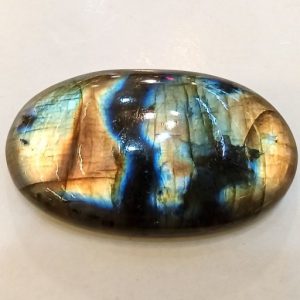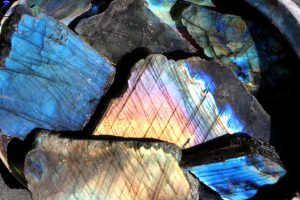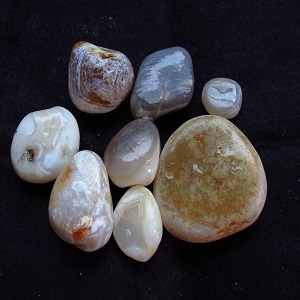?What is Labradorite
Labradorite stone is a semi-precious plagioclase stone composed of feldspar, which usually shows various colors when exposed to light. The flashing of these colors is called “Labradorescence”. Spectrolite is another name for this stunning stone

:Labradorite stone price
Labradorite is a beautiful semi-precious stone, whose jewelry prices are somewhat different, for example, labradorite stone rings and labradorite stone bracelets are different, and green labradorite stone has a higher value and price
:Identifying the original labradorite stone
Without seeing the reflective phenomenon of light and labradorsense color, it is difficult to recognize natural labradorites that do not have this play of color, and it requires tests such as x-rays, chemical analysis, optical tests, or its specific weight. Today, synthetic samples made of polymer materials are also produced as a substitute for labradorite
:Labradorite stone mines
Labradorite is found in metamorphic rocks (especially gneiss), sedimentary rocks and especially in mafic igneous rocks, gabbro, norite and anorthosite. Therefore, labradorite reserves are very abundant. The most important labradorite mines are Canada, Australia, Madagascar, Mexico, Russia, and America. A significant amount of gray to black labradorites with labradorsense color play are produced in Russia and Madagascar. In Madagascar, there is a clear blue labradorite known as Madagascar Moonstone. Small amounts of the clear type with internal color reflections are mined in India
:Color range in labradorite

The most popular and attractive color of labradorite is garlic blue, which was used for healing purposes in the past. The color of this stone is usually clear, white to gray in light reflection. In labradorescence phenomenon, colors can include blue, green, yellow, orange and red
Labradorite is a popular stone because of its play of colors. The quality, color and luster of labradorsense varies from sample to sample and even within a single sample. Transparent labradorite of exceptional colors and the best display of them, is often called “spectrolite”
:Labradorite stone cutting
One of the important uses of labradorite stone is in the jewelry industry. This stone is used in pendants, bracelets or rings. How to cut this stone is very important. The best way to reflect the play of labradorite color is visible only when the way of cutting is parallel to the inner layers of the stone; Because it is the inner layers of the rock that are responsible for producing this reflection. Also, since this stone is very fragile, the cutting of this stone should be done by experts in this field. Otherwise, the stone may be damaged
:Gemological and geological features of labradorite
Chemical formula: NaAlASi3O8 to CaAl2Si2O8 aluminum calcium sodium silicate
Crystal structure: broad and prismatic
Color: dark gray-blackish gray, no color, orange red, brownish

Difficulty: 6.5-6
Refraction: 1.559-1.570
Density: 2.65-2.75
Fracture: Complete
Transparency: transparent to opaque
Light refraction: 0.008 to 0.010
Shine: glassy
Fluorescence: with yellow streaks
?Which stones are similar or related to Labradorite
This stone is in the group of feldspars and therefore has the closest relationship with plagioclase. This relationship is due to the presence of calcium and sodium in their composition
Among these stones are Albite, Oligoclase, Andesine Labradorite, Bytownite and Anorthite
This group of stones have properties in their composition that these materials are found abundantly in the structure of the earth’s crust
Albite has more light refraction compared to labradorite, while oligoclase is lower than labradorite
Andesine also has a lower degree of light refraction compared to labradorite
Bitonite is usually colorless, white, gray or pale yellow, while labradorite has dark colors. Anorthite is more transparent than labradorite. Rainbow moonstone, which is generally obtained from Madagascar, is a transparent material that has a deep metallic blue color
:Now let’s talk about some famous labradorite types
Although many famous labradorites are unknown, a number of historically and culturally valuable examples exist
One of these examples is a stone soldier whose historical period remains uncertain and is kept in the Smithsonian Museum in Washington. Labradorite stone was used in the 19th century as a decorative material in St. Isaac’s Cathedral in St. Petersburg, Russia
:Labradorite care tips

Despite the fact that this stone has a hardness of 6 to 6.5 and is softer than quartz, it is a very resistant and durable material. To clean this material, use water, foam and a clean cloth
After washing the stone, rinse it completely and remove the soap completely
Before doing heavy activities, exercising or bathing, take off all your jewelry. Also, do not place labradorite next to other jewelry so that it does not get scratched
The best way to store it is in a soft cloth or in a gold and jewelry box covered with cloth




